|
|
|
Sort Order |
|
|
|
Items / Page
|
|
|
|
|
|
|
| Srl | Item |
| 1 |
ID:
180648
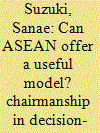

|
|
|
|
|
| Summary/Abstract |
ASEAN has adopted decision-making by consensus. Taking ASEAN as a case study, this article aims to explain how competing positions are reconciled and international agreements reached in organisations that have adopted consensus, a process that risks non-agreement because each participant has veto power, as their sole decision-making rule. ASEAN roundtables with the foreign ministers of its member states have indeed generated some meaningful agreements. I argue that rules and customs associated with ASEAN chairmanship effectively comprise a reconciliation mechanism. The chair is empowered to play an agenda-setting role, and the combination of rotating chairmanship and a limited number of member states means that every state will enjoy the strong power, within a reasonably short period of time. Since each state knows that its turn will come soon, all are willing to allow the others to exert the power of the chair and guide consensus toward agreements that are consistent with the chair’s national interests. This article analyses the impact of a strong ASEAN chair via empirical case studies of decisions reached (or not) under consensus regarding issues where member states had conflicting interests. This analysis of ASEAN decision-making contributes to the ongoing debate on effectiveness of ASEAN and has theoretical implications for the understanding of international organisations that operate under similar institutional settings.
|
|
|
|
|
|
|
|
|
|
|
|
|
|
|
|
| 2 |
ID:
180650
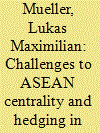

|
|
|
|
|
| Summary/Abstract |
Since 2010, ASEAN has made efforts to increase its coherence and visibility as an actor in regional infrastructure development, under the umbrella term of connectivity. Its most recent strategy, 2016’s Master Plan on ASEAN Connectivity 2025, is notable for its more focused agenda as well as a tableau of institutional innovations, including new policy coordination mechanisms and a project preparation pipeline. Nonetheless, ASEAN struggles to maintain coherence in the implementation of its connectivity agenda, both internally as well as towards its dialogue partners. Utilizing the concepts of centrality and hedging as parts of a unified theoretical framework, this paper analyzes ASEAN’s efforts to mobilize and manage external resources in connectivity. ASEAN’s resource dependence and its failure to establish institutional centrality creates issues at the regional and the national levels. Regionally, ASEAN’s lack of centrality and its perpetuation of ASEAN+1 relations have contributed to the emergence of contesting agendas and institutional frameworks by external actors. Nationally, the hedging strategies of ASEAN member states are at odds with the regional vision, highlighting a lack of intra-ASEAN coherence. The perpetuation of contesting institutional frameworks by external actors at the national level solidifies existing incoherence in ASEAN’s connectivity governance, further undermining its centrality. ASEAN’s efforts to assert centrality and execute a hedging strategy in connectivity are emblematic of its attempts to extend its reach into new policy areas, but also of its persistent governance constraints.
|
|
|
|
|
|
|
|
|
|
|
|
|
|
|
|
| 3 |
ID:
180653
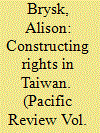

|
|
|
|
|
| Summary/Abstract |
In an era of worldwide rights regression, beleaguered Taiwan remains Asia’s most democratic, gender equitable, and liberal internationalist nation. What accounts for this seemingly exceptional record—and how does the feminist factor contribute to the construction of rights? Bridging constructivist and feminist scholarship, this essay argues that gender equity is a force multiplier for democratization as it empowers civil society and fosters legitimacy at home and abroad. In a three-level game, states at the margin of the international system may benefit from rights reform that expands the national interest and delivers material and reputational rewards. The case of Taiwan illustrates the dynamics of the double transition to liberal democracy and a liberal gender regime and its projection to world politics. The rewards of rights for Taiwan suggest a wider range of options even in small states facing regional challenges—and greater attention to the feminist factor in world politics.
|
|
|
|
|
|
|
|
|
|
|
|
|
|
|
|
| 4 |
ID:
180652


|
|
|
|
|
| Summary/Abstract |
There is an increasing proliferation of bilateral strategic partnerships in and beyond the Indo-Pacific region. Yet such a partnership between Japan and New Zealand is underexplored. The central aim of this article is to fill the gap. This article first clarifies the definition of, and then provides an analytical framework for, a ‘strategic partnership’. The article then analyses how these countries laid the foundation of their strategic partnership and how they have since built upon that foundation. In the implementation process of the strategic partnership, this article examines three elements: 1) the consolidation of their strategic partnership in official documents; 2) the institutionalisation of regular meetings; and 3) participation in defence and security exercises. Although the Japan-New Zealand strategic partnership is still in the early stages, this article argues that it has the potential to grow further given bipartisan support and positive perceptions in civil society in both countries. This article also analyses three factors that exert an impact on the development of their strategic partnership: China’s continued assertive maritime presence, the rejuvenation of the US-New Zealand bilateral relationship, and Japan and New Zealand’s ongoing commitment to the South Pacific region.
|
|
|
|
|
|
|
|
|
|
|
|
|
|
|
|
| 5 |
ID:
180651
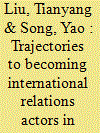

|
|
|
|
|
| Summary/Abstract |
While Chinese paradiplomacy has received growing academic attention, little is known about how different provinces within China act as international relations players of their own accord. This paper adopts a comparative perspective to address this gap. It develops three dimensions of international actorness (authority, motivation, and instruments) to examine whether and how Chinese provinces have satisfied the criteria for being international relations actors through their engagements in the Belt and Road Initiative (BRI). Using Guangdong and Yunnan as examples, this paper casts light on the plural occasions in which the de-centralized state control of foreign affairs and the growing external activism of provincial entities have worked in tandem to widen the footprints of said provincial entities in the countries of the BRI. Drawing on Guangdong-Hong Kong competition and Yunnan-Guangxi rivalry, this paper unpacks the motivations of provincial engagements in the BRI by exploring the utility of imitation tactics used to gain comparative advantages vis-à-vis their domestic counterparts. While comparing the Guandong and Yunnan’s leveraging of strategic instruments, this paper also reveals Guangdong’s strong globalist, mercantile mentality in its external interactions, in contrast with the more regionalist and stability-oriented approach of Yunnan.
|
|
|
|
|
|
|
|
|
|
|
|
|
|
|
|
| 6 |
ID:
180649
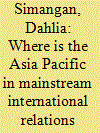

|
|
|
|
|
| Summary/Abstract |
Some scientists propose that the Earth has entered the Anthropocene—a new geological age in which human activities have become the driving force behind global environmental changes. Several disciplines outside the natural sciences have engaged with debates surrounding the Anthropocene, including International Relations (IR), in order to theorise their relevance in this new age. To pluralise this burgeoning research area and contribute to the updating of the IR discipline’s engagement with the Anthropocene discourse, this study seeks to locate and highlight the Anthropocene themes and narratives related to the Asia-Pacific region. A systematic review of the literature reveals knowledge gaps in the IR discipline’s engagement with the Asia Pacific as a unique region in the Anthropocene, encouraging a more robust analysis of regional or multi-level anthropogenic contributions, closer investigation of differentiated experiences of vulnerability, and further articulation of contextualised yet globally significant solutions to environmental threats. The mainstream scholarship needs to engage with the Asia-Pacific experience(s) in the Anthropocene considering the region’s vulnerability to the challenges of the Anthropocene and, at the same time, responsibility for increased anthropogenic factors.
|
|
|
|
|
|
|
|
|
|
|
|
|
|
|
|
|
|
|
|
|